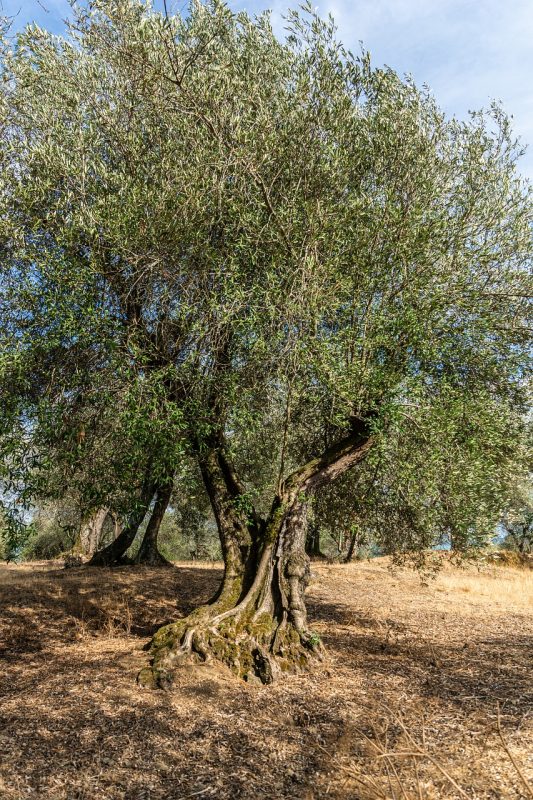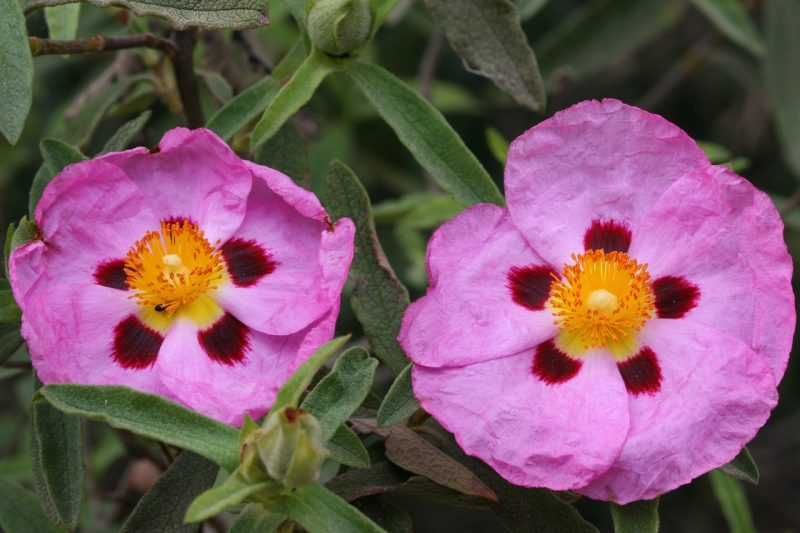Flowering Plants
When envisioning a Tuscan garden, one cannot overlook the vital role that flowering plants play in creating the quintessential Mediterranean atmosphere. These vibrant plants not only contribute to the garden’s aesthetics but also harmonize splendidly with the region’s sunny climate and well-drained soils.
Lavender
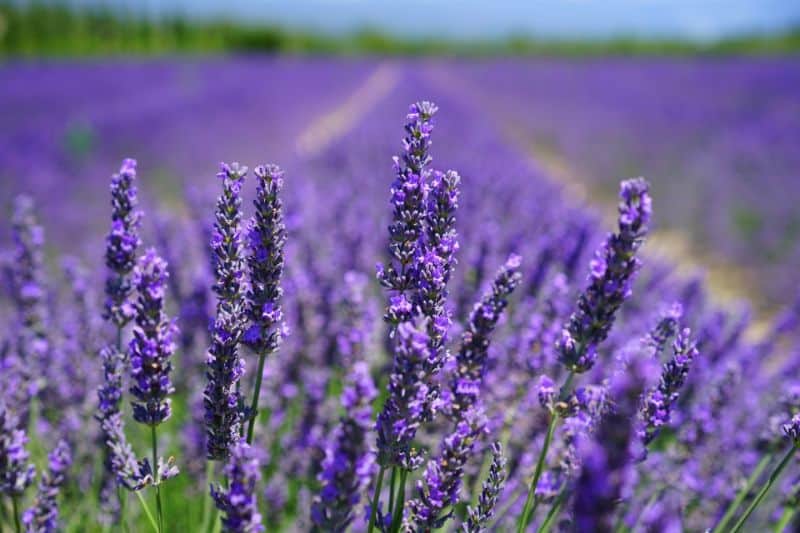
Lavender (Lavandula spp.) is a staple of Tuscan landscapes, renowned for its enchanting scent and striking purple blooms. This perennial shrub is celebrated not just for its beauty but for its versatility. The fragrant spikes of lavender are commonly used in aromatherapy, herbal remedies, and culinary dishes, making it both a practical and aesthetic choice for any Mediterranean garden.
Ideal Conditions: Lavender flourishes in full sun and prefers well-drained, sandy, or rocky soils. A crucial tip for gardeners is to ensure that lavender is not overwatered, as this can lead to root rot. The best time to plant lavender is in the spring or fall, when the plant can establish its roots before the heat of summer.
Companion Planting: Lavender does not only stand alone; it pairs beautifully with other drought-tolerant plants like sage and thyme. These companions not only amplify the Mediterranean vibe but also share similar watering needs, creating a harmonious garden ecosystem.
Wildlife Support: Beyond its visual appeal, lavender is instrumental in supporting local wildlife. It attracts bees, butterflies, and other beneficial insects, enhancing the garden’s biodiversity. When in full bloom, a patch of lavender becomes a buzzing hub of activity, showcasing nature’s intricate dance of pollination.
Culinary Uses: The culinary potential of lavender is an often-overlooked aspect. Its flowers can be infused in teas, used to flavor desserts, or even incorporated into savory dishes. Lavender sugar and lavender-infused oils are popular culinary concoctions that reflect its versatility.
Rosemary
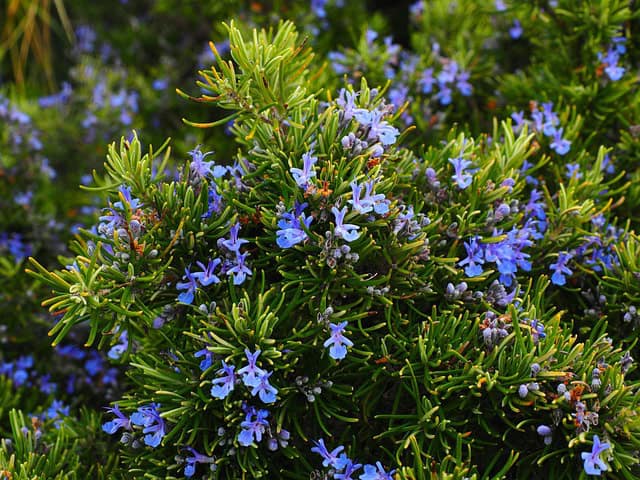
Rosemary (Rosmarinus officinalis), much like lavender, is emblematic of Tuscan gardens, known for its aromatic leaves and woody stems. This evergreen herb carries a rich history and is deeply intertwined with Mediterranean cuisine, traditional medicine, and cultural symbolism.
Ideal Growing Conditions: Rosemary thrives in full sun and well-drained soils, preferring slightly alkaline conditions. For successful cultivation, it’s essential to mimic its native Mediterranean environment—good air circulation and minimal humidity are key. Given its drought resistance, rosemary is perfect for gardeners looking for low-maintenance plants.
Culinary Highlights: Rosemary is a fundamental herb in Tuscan cuisine, adding depth to savory dishes like roasted meats and vegetables. Its pungent aroma and flavor elevate olive oil and are a common ingredient in marinades and stews. Beyond the kitchen, fresh rosemary can be used in herbal teas to promote digestion and improve mood.
Cultural Significance: In addition to its culinary applications, rosemary is steeped in cultural significance. Historically, it symbolizes remembrance and fidelity, often used in weddings and funerals alike. Its folklore carries connotations of love and loyalty, making it a meaningful addition to any garden dedicated to invoking a spirit of affection.
Aromatic Foliage: The distinct scent of rosemary is not just appealing to humans; it also acts as a natural deterrent against pests like mosquitoes and certain insects. This makes it not only a delightful addition but also a beneficial one that enhances the ecosystem of your Mediterranean garden.
Jasmine
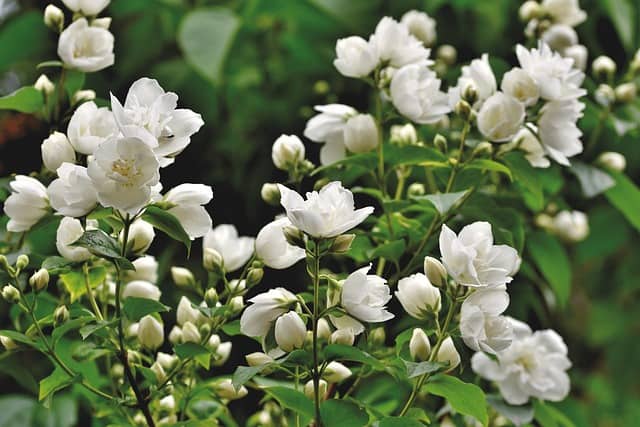
Jasmine (Jasminum spp.) is a quintessential flowering vine that embodies the romance of the Mediterranean. Known for its delicate white or yellow blossoms, jasmine is not just visually captivating but is also revered for its intoxicating fragrance that wafts gracefully through the garden air, particularly in the warm evenings.
Ideal Growing Conditions: Jasmine thrives in well-drained soil and prefers conditions with full to partial sun. It can adapt to various soil types but flourishes best in slightly acidic to neutral pH levels. A trellis or support structure is recommended, as the vine requires guidance to reach its climbing potential. Pruning after flowering is essential to encourage healthy growth and abundant blooming in the following season.
Cultural Significance: Jasmine has long been associated with love and beauty, often used in traditional weddings across cultures. Its flowers are sometimes woven into floral garlands, symbolizing purity and the bond between lovers. This cultural heritage adds an enchanting aspect to any garden, inviting sentiments of romance and devotion.
Aromatic Applications: Beyond the garden, jasmine flowers are prized in the perfume industry for their rich scent. Additionally, jasmine tea, made from the flowers, is celebrated for its soothing properties and delightful flavor, serving as a reminder that this plant’s allure extends far beyond its beauty.
Violet

Violet (Viola spp.) is a subtle yet captivating flower that adds a touch of elegance to Tuscan gardens. With its enchanting hues ranging from deep purple to soft lavender and white, violets are perfect for creating charming borders or filling in shady spots under trees. Their early spring blooms herald the arrival of warmer weather.
Ideal Growing Conditions: These delicate flowers prefer rich, well-draining soil and thrive in partial shade to full sun. While violets can tolerate a range of moister levels, they flourish best in slightly damp conditions. Consistent watering during dry spells is crucial, particularly in summer, to maintain their lush, vibrant appearance.
Culinary Uses: Violets are not only a treat for the eyes but also for the palate. The flowers are edible and can be used to adorn salads, desserts, and drinks. Their sweet, floral flavor enhances culinary creations, while candied violets make a stunning and delightful garnish for cakes and pastries.
Symbolism and Medicinal Properties: Violets carry a symbolism of love, faithfulness, and intuition, making them significant in various cultural traditions. Additionally, they have been used in traditional medicine for their anti-inflammatory properties and to treat ailments such as respiratory issues and skin problems. Including violets in your garden offers both beauty and health benefits.
Iris
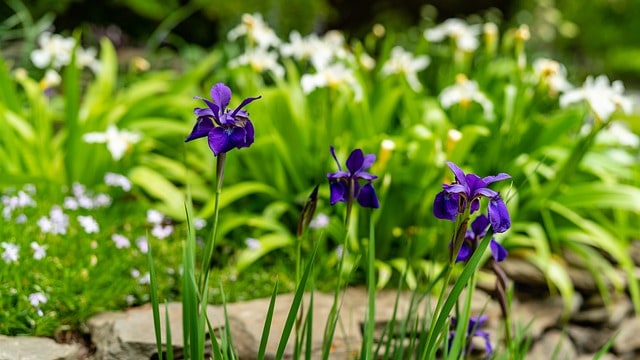
The elegant Iris (Iris spp.) commands attention with its striking, intricate blooms. Available in a multitude of colors, irises can serve as bold focal points in any garden arrangement. These perennial plants evoke the spirit of Tuscany, reflecting the vibrant flora commonly found across the region.
Ideal Growing Conditions: Irises thrive best in sunny locations with well-draining soil. They are relatively drought-tolerant once established but benefit from consistent moisture during their growing season. It is important to plant iris rhizomes with their tops exposed to avoid rot and promote healthy growth.
Diversity and Varieties: With over 300 species, irises offer a diversity of forms and colors, allowing gardeners to create unique combinations. The German iris, bearded iris, and Siberian iris are just a few examples showcasing the adaptable nature of this resilient flower. Their varying bloom times extend the flowering season, providing continuous bursts of color from spring to early summer.
Cultural Significance: The iris holds rich historical significance, often symbolizing wisdom, courage, and hope. In ancient Greece, the flower was associated with the goddess Iris, the messenger, creating a mythology around its beauty. This symbolism invites gardeners to create spaces not just for visual enjoyment, but also for reflection and inspiration.
Pollinator Haven: Irises are known to attract a variety of pollinators, particularly bees and butterflies. Their vibrant colors and unique shape encourage pollinators to visit, making them a valuable addition to biodiversity in the garden. Creating a pollinator-friendly landscape highlights the interconnectedness of nature and supports local ecosystems.
Shrubs and Trees
A Mediterranean garden flourishes when it features an array of robust shrubs and trees that embody the spirit and climate of Tuscany. These plants not only offer structure and longevity but also enhance the garden’s character with their unique shapes and rich histories. In this section, we highlight two prominent representatives of Tuscan landscapes: the Italian Cypress and the Olive Tree, each bringing its charm and significance to the garden.
Italian Cypress
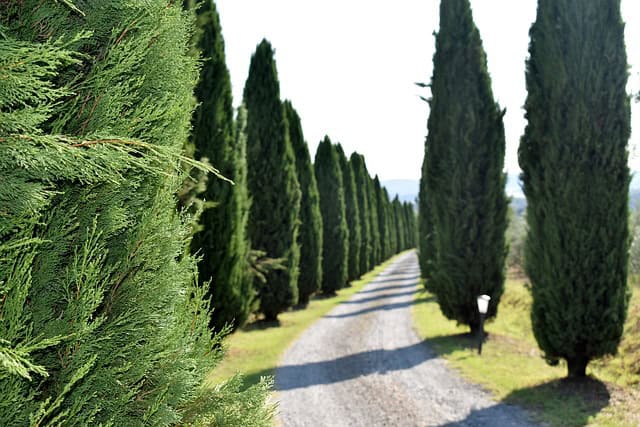
The Italian Cypress (Cupressus sempervirens) is a tall, slender conifer renowned for its elegant, column-like shape. Standing as a symbol of the Tuscan landscape, these trees evoke the classic image of rolling hills dotted with stately cypress rows, often leading the eye toward ancient villas and breathtaking vistas.
Ideal Growing Conditions: This resilient tree is perfectly suited to the Mediterranean climate, thriving in full sun and well-drained soil. Italian cypress can tolerate drought, making them ideal for low-water gardens. They prefer alkaline soil and can benefit from occasional pruning to maintain their prominent shape.
Cultural and Historical Significance: The Italian Cypress has long been associated with mourning and immortality, often found in cemeteries and gardens. Its towering presence carries cultural weight and historical significance, symbolizing hope and remembrance. These trees add an emotional layer to the landscape while embodying Tuscany’s timeless beauty.
Aesthetic Versatility: Italian cypress trees make striking focal points or elegant privacy screens in gardens. They serve as excellent backdrops to flowering plants and shrubs, their vertical lines contrasting beautifully with more rounded forms. Planting them in clusters or as accents along pathways can create a visually dramatic effect, enhancing the overall composition of your garden.
Wildlife Benefits: These trees also provide shelter for various bird species, offering a safe haven for nesting and roosting. As a result, incorporating Italian cypress into your garden not only enhances its beauty but also supports local wildlife, contributing to a more vibrant and diverse ecosystem.
Olive Tree
The Olive Tree (Olea europaea) is another iconic element of Tuscan gardens, recognized not only for its historical value but also for its culinary and ecological significance. These ancient trees, often gnarled and twisted, speak to the enduring spirit of the Mediterranean and offer a sense of timelessness.
Ideal Growing Conditions: Olive trees thrive in well-drained, sandy soils and full sunlight, making them perfectly adapted to Mediterranean climates. They are drought-resistant once established, making them an ideal choice for gardeners seeking low-maintenance options. Regular pruning helps maintain their shape and encourages vigorous fruit production.
Culinary and Culinary Uses: The olives produced by these trees are culinary jewels, celebrated for their rich flavor profiles and health benefits. Olive oil, pressed from their fruit, is a cornerstone of Mediterranean cuisine, known for its versatility and heart-healthy properties. Growing an olive tree provides a personal connection to this culinary tradition, offering fresh olives or homemade oil for your kitchen.
Symbolism and Cultural Importance: The olive tree holds a sacred place in Mediterranean culture, symbolizing peace, wisdom, and endurance. In ancient Greece, olive branches were awarded to victors in athletic competitions, exemplifying their significance in historical narratives. For modern gardeners, planting an olive tree can serve as a personal emblem of resilience and connection to the earth.
Ecological Contributions: Beyond its cultural and culinary significance, the olive tree plays a vital role in the local ecosystem. It attracts pollinators such as bees and various bird species, which benefit from the fruits and nectar provided. By planting olives, gardeners can enrich their environment and support biodiversity, creating a garden that thrives on interconnectedness.
Bay Laurel

Bay Laurel (Laurus nobilis), often recognized for its aromatic leaves, is a cherished shrub that thrives in the Mediterranean climate. Its versatile nature makes bay laurel a standout in culinary uses, landscape design, and even ancient lore.
Ideal Growing Conditions: Bay laurel prefers well-drained soil and full sun, though it can tolerate partial shade as well. This hardy evergreen can prosper in various soil types, from sandy to clay, as long as it has good drainage. Regular pruning encourages bushier growth and keeps the plant manageable in size.
Culinary Applications: The leaves of the bay laurel plant have long been used in culinary traditions, especially in Mediterranean dishes. Dried leaves are a key flavoring agent in soups, stews, and sauces, imparting a subtle depth of flavor that enhances many savory recipes. Fresh bay leaves can also make a fragrant addition to marinades and brines, elevating home-cooked meals.
Cultural Significance: In ancient Greece, bay laurels were a symbol of victory and honor, leading to the tradition of crafting laurel crowns for champions. This historic significance adds layers of meaning to the plant, making it not just a culinary herb but also a botanical emblem of achievement. Integrating bay laurel into your garden can evoke a sense of connection to this rich cultural heritage.
Wildlife Habitat: Bay laurel also provides habitat and food for a variety of fauna. Its glossy leaves can serve as shelter for small birds and its flowers attract pollinators, such as bees, thus supporting the ecosystem. By planting bay laurel, gardeners create a more inviting environment for wildlife while benefiting from its practical uses.
Oleander

Oleander (Nerium oleander) is a bold, flowering shrub that makes a striking addition to any Tuscan garden. Known for its stunning clusters of pink, white, or red flowers, oleander not only draws the eye but also thrives in the hot, arid conditions typical of Mediterranean climates.
Ideal Growing Conditions: Oleander is exceptionally drought-tolerant and prefers well-drained soils, making it easy to maintain, even in the hottest weather. It flourishes in full sun, which encourages maximum flowering. While oleander can tolerate poor soil conditions, good drainage is essential to prevent root rot.
Cautionary Note: While oleander is beautiful, it is also highly toxic if ingested. Every part of the plant contains compounds harmful to humans and animals, so care must be taken when planting in areas frequented by pets or children. Despite this caution, oleander is considered safe when admired from a distance, providing a striking visual impact without the need for touch.
Aesthetic Appeal: The visually striking blooms of oleander create a lush backdrop and can serve as privacy hedges or landscape boundaries. Their long flowering season means these plants often brighten gardens well into the fall, adding color and vibrancy throughout the year.
Resilience Against Pests: Oleander is resistant to many pests and diseases, allowing it to thrive with minimal intervention. This resilience makes it an excellent choice for gardeners seeking a low-maintenance, high-impact plant that ensures a stunning display with little effort.
Holm Oak
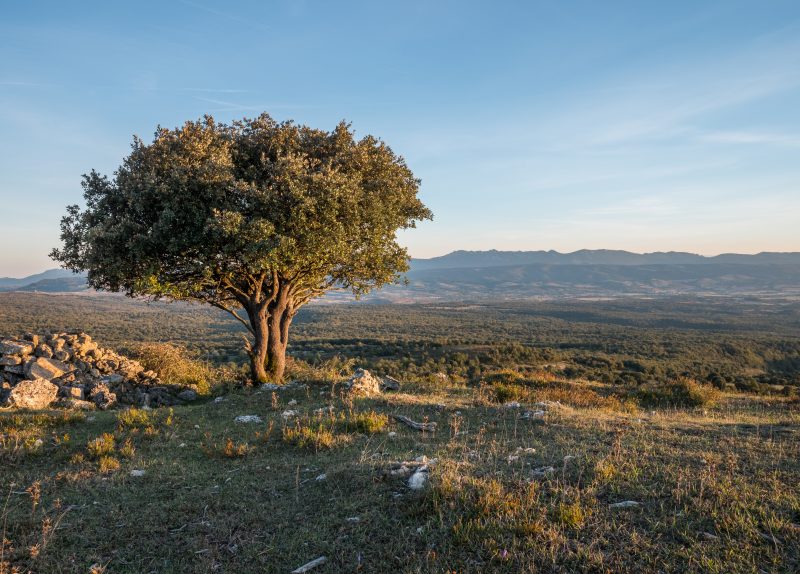
Holm Oak (Quercus ilex), also known as the “evergreen oak,” is a magnificent tree that adds strength and structure to Tuscan gardens. Its lush, dark green leaves provide a picturesque backdrop for the vibrant flowers and shrubs typically found in a Mediterranean landscape.
Ideal Growing Conditions: Holm oak trees thrive in well-drained soils and are particularly resilient to drought, making them well-suited for the hot, dry climates typical of Tuscany. They prefer full sun but can tolerate partial shade, giving them versatility in placement, whether as a focal point or part of a hedge.
Cultural Significance: In Italian culture, the holm oak is often associated with strength and longevity. These trees can live for several hundred years, creating a sense of historical continuity in the landscape. Their significant presence contributes to the timeless aesthetic of Tuscan gardens, linking them to the past.
Shade and Microclimate Creation: One of the remarkable features of the holm oak is its ability to provide substantial shade. Their broad canopies help to create microclimates within the garden, allowing for cooler, sheltered spots that can support a variety of underplantings. This can be an advantage during extremely hot summers, enabling the growth of more delicate plants that may not withstand full sun exposure.
Support for Wildlife: The holm oak is a keystone species in Mediterranean ecosystems, supporting a range of wildlife, including insects, birds, and small mammals. Its acorns are a vital food source for various creatures, while the dense foliage offers nesting sites. Thus, including holm oak in your garden can promote ecological health while providing beauty and structure.
Rose of Tuscany

The Rose of Tuscany (Rosa floribunda) is a beloved flowering shrub that captures the essence of the Tuscan landscape with its lush blooms and delightful fragrance. These roses are known for their hardiness and ability to thrive in the often challenging climate of the Mediterranean.
Ideal Growing Conditions: The Rose of Tuscany flourishes in well-drained soil and benefits from full sun exposure, although it can tolerate some afternoon shade. These roses are relatively drought-tolerant, making them well-suited for the Mediterranean climate, where arid conditions can prevail.
Aesthetic and Aromatic Qualities: Known for their multitude of colors, the roses can range from soft pastels to vibrant reds, making them a versatile choice for any garden design. Their strong, sweet fragrance adds an additional sensory dimension, inviting visitors to immerse themselves in the garden’s romantic ambiance. Planting them along pathways or near seating areas enhances the overall experience.
Cultural Significance: Roses have deep-rooted symbolic meanings, often representing love and beauty. In Tuscany, they evoke the region’s rich artistic heritage and historical gardens, where they have been cultivated for centuries. Including the Rose of Tuscany in your garden allows you to partake in this cultural tapestry while celebrating the beauty of nature.
Pollinator Friendly: The Rose of Tuscany is an excellent choice for attracting pollinators, particularly bees and butterflies
Phoenician Juniper
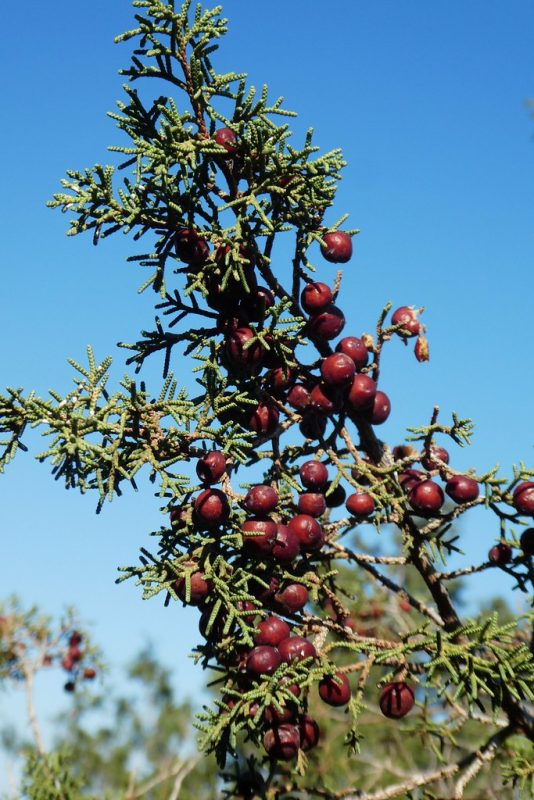
The Phoenician Juniper (Juniperus phoenicea) is a striking plant that embodies the rugged beauty of the Mediterranean landscape. This hardy evergreen shrub or small tree not only contributes to the aesthetics of Tuscan gardens but also offers a range of ecological benefits, making it a standout choice for any Mediterranean planting scheme.
Ideal Growing Conditions: Phoenician Juniper thrives in well-drained, sandy, or rocky soils. It is highly tolerant of drought and salt, making it particularly suited to coastal settings as well as inland gardens where water conservation is a priority. Its preference for sunny locations enhances its growth and resilience, ensuring that it flourishes even in the heat of the Tuscan summer.
Aesthetic and Architectural Elements: The Phoenician Juniper’s distinctive foliage, characterized by its scale-like leaves and dense growth habit, adds texture and depth to a garden design. Its ability to grow in a variety of shapes—from low, sprawling ground covers to upright forms—makes it a versatile choice for creating visual interest. These characteristics encourage its use as a focal point, a natural privacy screen, or a dynamic element in rock gardens.
Cultural and Historical Connections: This juniper species has been integral to Mediterranean landscapes for centuries, often associated with traditional uses in crafts and medicine. The wood is aromatic and durable, historically utilized for making fences, furniture, and other artisan goods. By including Phoenician Juniper in your garden, you invite a piece of this enduring cultural legacy.
Wildlife Habitat: The Phoenician Juniper is also beneficial for wildlife, providing shelter and food for various bird species. Its berries are a food source for birds and small mammals, while the dense foliage offers nesting sites, promoting a healthy and balanced ecosystem in your garden. Incorporating this juniper species can enhance biodiversity, creating a more vibrant environment.
Grasses and Ground Covers
A flourishing Mediterranean garden often includes a variety of grasses and ground covers that enhance its overall structure while providing practical advantages such as erosion control and low maintenance. Among the popular selections for Tuscan gardens are Blue Fescue Grass and other visually appealing ground covers.
Blue Fescue Grass
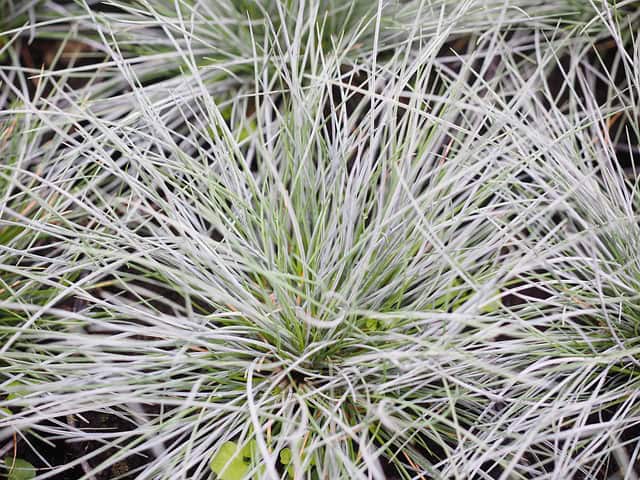
Blue Fescue (Festuca glauca) is a captivating ornamental grass characterized by its striking blue-green foliage and compact growth habit. This grass is a favorite in Mediterranean landscaping for its versatility and aesthetic appeal.
Ideal Growing Conditions: Blue Fescue thrives in well-draining soil and prefers full sun but can accommodate light shade. It is highly drought-resistant once established, making it suitable for low-water gardens typical in the Tuscan region. It flourishes in a variety of soil types, from sandy to rocky, showcasing its adaptability to Mediterranean conditions.
Aesthetic Appeal: The unique color of Blue Fescue sets it apart in any garden, bringing a cool, serene touch that can complement the warmer hues of flowering plants. Its tufted growth form creates a lovely contrast when paired with low-growing perennials or flowering shrubs, making it an ideal choice for borders, mass plantings, or rock gardens.
Seasonal Interest: Blue Fescue provides year-round interest, maintaining its striking blue color throughout the seasons. In the summer, it produces delicate flower spikes that rise above the foliage, adding an airy quality to garden beds. Even in winter, the grass’s sturdy structure remains visually appealing, providing texture amidst the dormant landscape.
Low Maintenance and Erosion Control: As a perennial grass, Blue Fescue requires minimal maintenance once established. Its dense root system helps to stabilize soil, making it an excellent choice for erosion control in sloped areas or xeriscaped gardens. This practical aspect allows gardeners to achieve a picturesque landscape while promoting sustainability and reducing the need for excessive watering or fertilizer.
Pollinator-Friendly: Blue Fescue’s flowers attract pollinators such as bees and butterflies, adding to the ecological benefits of a Mediterranean garden. By incorporating this grass, gardeners can create vibrant spaces that support local wildlife, further enhancing the overall health of the garden ecosystem.
Cistus
Cistus, commonly known as rockrose, is a remarkable genus of shrubs that thrives in the sun-drenched landscapes of the Mediterranean, including the Tuscan region. This plant’s resilience and beauty make it a staple in Mediterranean gardens, where it not only provides visual appeal but also supports the local ecosystem.
Ideal Growing Conditions: Cistus flourishes in dry, rocky soils and prefers full sun exposure. This plant is highly drought-tolerant once established, making it ideal for the hot, arid conditions characteristic of the Tuscan summer. Its adaptability to poor soil makes it a perfect choice for gardeners looking to create a low-maintenance landscape that still showcases vibrant beauty.
Aesthetic Qualities: The Cistus species produce stunning, showy flowers that come in hues ranging from white to deep pink and magenta. These flowers are often crinkled in appearance and bloom profusely in late spring and early summer, creating a dazzling display against the backdrop of the plant’s evergreen foliage. Their striking blooms not only attract attention but also provide a boost of color to the garden, making them ideal for mass plantings or as eye-catching focal points.
Ecological Benefits: Rockrose plants are beneficial for local wildlife, particularly pollinators such as bees and butterflies. As a nectar-rich source, the flowers contribute to the overall health of the ecosystem. Additionally, their dense foliage offers shelter for various small birds, enhancing biodiversity within the garden setting.
Cultural and Traditional Uses: Historically, Cistus has been valued for its aromatic properties, with certain species producing a resin known as labdanum. This resin has been used in perfume production since ancient times. Incorporating Cistus into your garden not only brings beauty but also a connection to traditional crafts and the fragrance-filled legacy of the Mediterranean.
Thyme
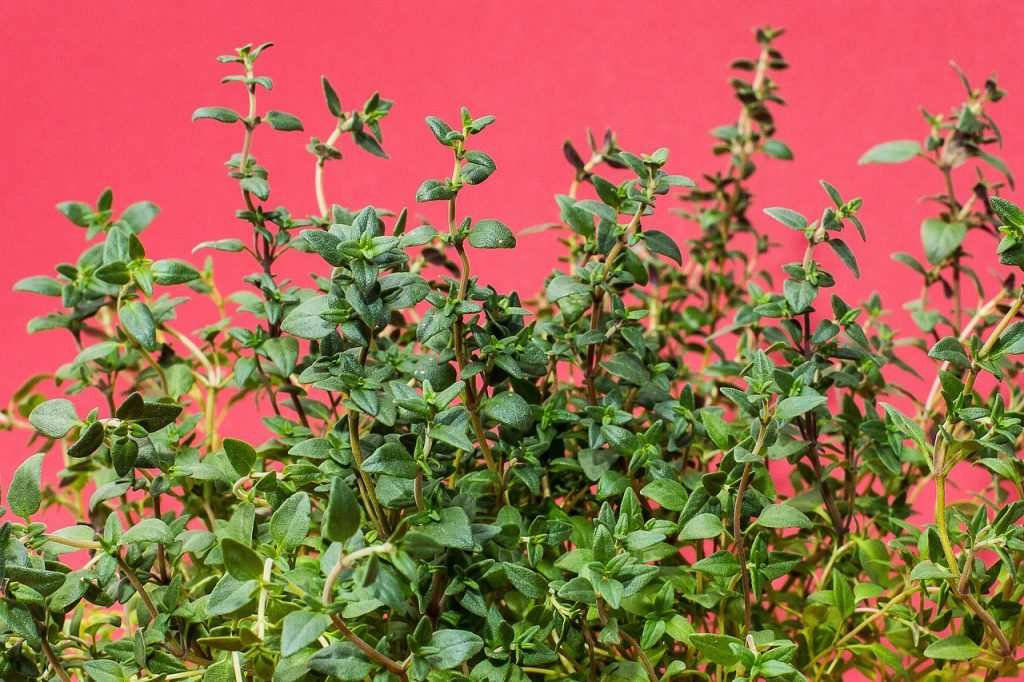
Thyme (Thymus vulgaris) is another essential element of Mediterranean gardens, particularly in Tuscany, where it serves both culinary and ornamental purposes. This hardy herb, cherished for its fragrant leaves, thrives in sunny, well-drained locations, making it a fitting choice for drought-resistant gardens.
Ideal Growing Conditions: Thyme thrives in lean, well-draining soil and benefits from full sunlight. It is highly tolerant of heat and dry conditions, making it an excellent plant for Mediterranean climates. Its low-growing habit and sprawling nature allow it to fill in spaces between stones, gravel, or other plants, creating a cohesive and layered garden design.
Culinary Applications: Thyme is a staple herb in Mediterranean cuisine, prized for its aromatic qualities that enhance various dishes, from meats and vegetables to soups and sauces. Fresh or dried, its leaves pack a flavorful punch and are often used to infuse oils or make marinades. Having thyme in your garden ensures easy access to this essential ingredient, inviting culinary creativity.
Aesthetic and Functional Ground Cover: In addition to its culinary uses, thyme can also function as an attractive ground cover. Its dense mat forms bright green foliage that produces delicate purple flowers in summer, an enticing sight that attracts bees and butterflies. The aromatic foliage releases a pleasant scent when brushed against, adding to the sensory experience of your garden.
Resilience and Minimal Care: This hardy herb requires little care once established, making it ideal for busy gardeners. It does well with minimal watering and can withstand occasional neglect, promoting a low-maintenance approach to gardening while still providing beauty and functionality. Its ability to thrive in arid conditions accentuates its suitability for sustainable landscaping practices.
Climbing Plants
Climbing plants add vertical interest and dimension to the landscape of a Tuscan Mediterranean garden. They can soften walls, enhance trellises, and provide natural shade, playing a key role in creating a lush, inviting atmosphere.
Honeysuckle
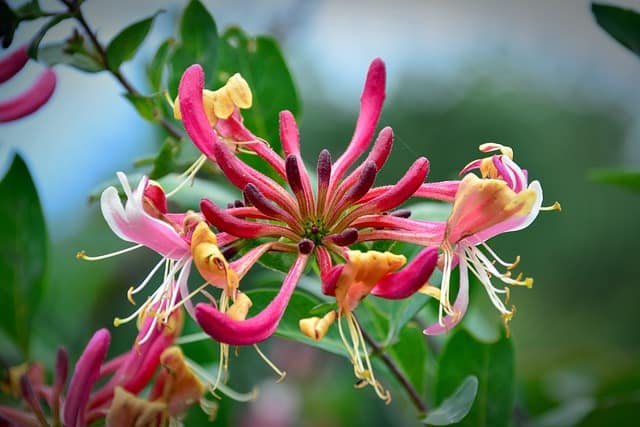
Honeysuckle (Lonicera), particularly the perennial varieties well-suited for Mediterranean climates, is a delightful addition to Tuscan gardens. Known for their sweetly scented flowers and vibrant colors, honeysuckle plants bring not only beauty but also rich ecological benefits to the landscape.
Ideal Growing Conditions: Honeysuckle thrives in well-drained soils and enjoys full sun but can tolerate partial shade, making it adaptable to various garden settings. In Tuscan gardens, it can flourish with minimal irrigation once established, as it efficiently manages to grow in the warm, dry climate characteristic of sunny afternoons.
Aesthetic Charm: The flowers of honeysuckle come in a range of hues—cream, yellow, pink, and red—providing vibrant splashes of color throughout the growing season. Their tubular shape is particularly attractive to hummingbirds and pollinators, enhancing the garden’s lively ambiance. By training honeysuckle to climb trellises, fences, or arches, gardeners create enchanting vertical displays that gracefully intertwine with other garden elements.
Fragrant Blooms and Ecological Significance: The intoxicating fragrance of honeysuckle blooms can fill the air, making them ideal for planting near patios, pathways, or open windows. Their rich nectar draws in bees, butterflies, and other pollinators, playing a crucial role in supporting local ecosystems. The dense foliage provides shelter for birds and small wildlife, helping to create a biodiverse garden environment.
Cultural Associations: Honeysuckle has deep-rooted significance in various cultures, often symbolizing love and devotion. This rich symbolism enhances the garden’s narrative, making it not just a space for growth but a place filled with meaning. Incorporating honeysuckle adds layers of personal connection to your garden, ensuring that it is not only a visual feast but a cherished sanctuary.
Clematis
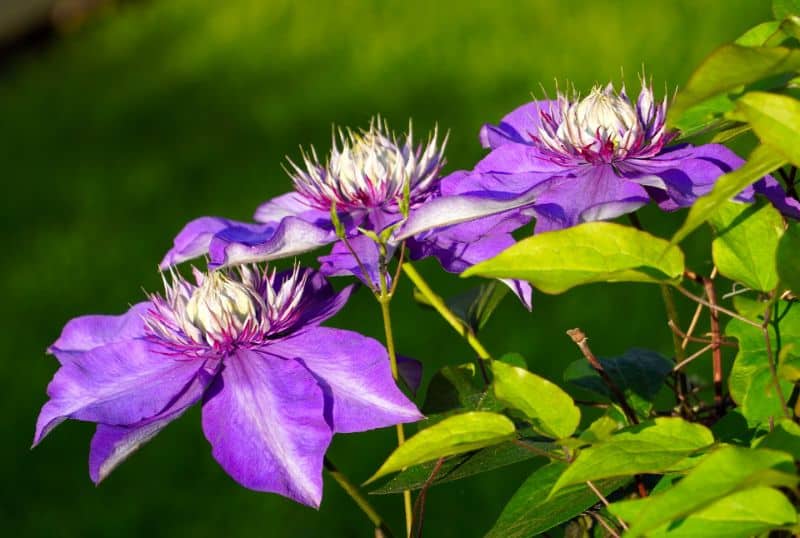
Clematis, an exquisite group of flowering vines, is a perennial favorite among gardeners looking to create a lush and vibrant Mediterranean garden. With a stunning array of species and varieties, clematis promises dazzling blooms that can transform any outdoor space.
Ideal Growing Conditions: Clematis prefers well-drained soil and thrives in sunny to partially shaded spots. While some varieties are more tolerant of drought than others, they generally benefit from consistent moisture, particularly during flowering. This makes proper watering essential, especially during dry spells that are typical in Tuscan summers.
Aesthetic Diversity: One of the most appealing aspects of clematis is its variety. Ranging from small, star-shaped blossoms to large, ruffled blooms, the flowers can come in purples, blues, whites, and pinks, creating a vivid tapestry in the garden. Clematis can be used to cover trellises, walls, and even dappled trees, providing vertical interest and softening hard edges with its graceful trailing vines.
Seasonal Interest: Depending on the species, clematis can provide blooms from early spring to late fall, ensuring that the garden remains colorful throughout much of the growing season. This prolonged bloom time allows clematis to act as a continuous source of beauty, making it an invaluable addition to any Tuscan-style garden.
Support for Pollinators: Clematis flowers are not only beautiful, but they also attract pollinators, such as bees and butterflies, contributing to a healthy garden ecosystem. By including clematis in your planting scheme, you can create a vibrant habitat that fosters local wildlife and promotes biodiversity.
Bougainvillea
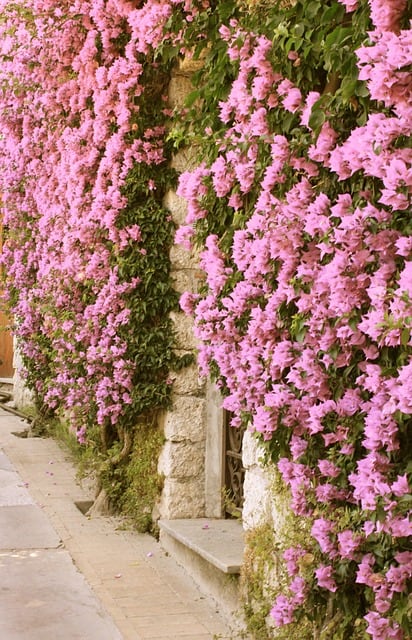
Known for its flamboyant colors and lush growth, Bougainvillea is an iconic plant within Mediterranean gardens, perfectly suited to the warm, sunny climates of Tuscany. This vibrant vine brings a tropical flair to outdoor spaces, transforming walls, trellises, and fences into stunning floral displays.
Ideal Growing Conditions: Bougainvillea flourishes in well-drained, poor soils and thrives in full sun, making it highly suited to Tuscan gardens. The plant’s drought tolerance allows it to flourish in dry conditions where other species may struggle, contributing to a low-maintenance landscape that retains its splendor with minimal watering.
Dazzling Display: One of the most enchanting features of Bougainvillea is its bright bracts, which can come in various shades of purple, pink, red, orange, and white. These colorful papery bracts surround small, inconspicuous white flowers, providing a lasting show of color. Bougainvillea vines can be trained to climb, creating cascading displays that complement and enhance the architecture of a garden.
Cultural Resonance: Bougainvillea is often associated with the Mediterranean lifestyle, representing warmth and beauty. Its vibrant presence evokes the feel of sun-soaked terraces and vibrant outdoor spaces typical of Tuscan villages. Integrating this plant into your garden design allows for a touch of local history and culture, enriching the garden’s charecter.



